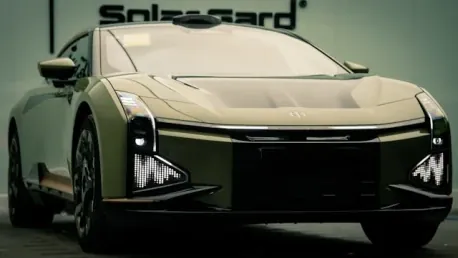The expanding global smart car market and its cybersecurity challenges are poised to become a pivotal topic of discussion in the years to come. The market’s growth, which is expected to reach $265.7 billion by 2032, underscores the increasing significance of advanced technologies such as AI, 5G, and autonomous driving in modern vehicles. However, this rapid development raises significant concerns about cybersecurity risks due to the intricate and interconnected nature of smart cars. The growing dependency on technology has made these vehicles highly susceptible to a variety of threats that could have serious repercussions for both individual users and manufacturers. This article delves into the myriad cybersecurity threats that modern smart vehicles face, explores the potential consequences of such breaches, and evaluates the strategies essential for mitigating these risks.
The Rise of Smart Cars
The projected 17 percent compound annual growth rate (CAGR) in the smart car market highlights the importance of addressing the cybersecurity aspects associated with connected vehicles. As smart cars continue to integrate more sophisticated technologies, ensuring cybersecurity becomes paramount for maintaining both safety and reliability. The innovation driving the market also introduces a range of new and unique vulnerabilities. Modern smart vehicles, which rely heavily on advanced software, connectivity, and complex computer systems, expose themselves to various cybersecurity threats. Such threats are not merely hypothetical; they represent real dangers that could disrupt the core functioning of these high-tech automobiles.
This interconnected environment of smart cars makes them particularly susceptible to cybersecurity breaches, leading to significant long-term implications for both drivers and manufacturers. Key areas of vulnerability include vehicle control systems, data and privacy breaches, in-vehicle infotainment systems, keyless entry and ignition systems, and over-the-air (OTA) updates. By delving into these categories, the severity and diversity of the risks become apparent. For instance, vulnerabilities in vehicle control systems can give hackers the ability to manipulate critical functions such as steering, braking, and acceleration, thereby creating serious safety hazards. Furthermore, the interconnected systems within a car mean that an attack on one component can quickly cascade, undermining the entire vehicle’s integrity.
Types of Automotive Cybersecurity Risks
Understanding the intricacies of automotive cybersecurity risks begins with recognizing the variety of threats to which smart vehicles are exposed. One of the most critical areas of concern is vehicle control systems. Hackers who compromise these electronic control units (ECUs) can potentially take control of essential functions like steering, braking, and acceleration. Such breaches not only pose severe safety risks but can also lead to catastrophic accidents and considerable injuries. Additionally, connected cars gather extensive amounts of personal data, including driver information, location history, and even in-car conversations. Breaches in this data can result in serious consequences such as identity theft, unauthorized surveillance, or even blackmail.
In-vehicle infotainment systems represent another notable vulnerability. These systems, designed to enhance the driving experience through connectivity and entertainment, can be exploited by hackers to access personal data, install malware, or disrupt vehicle operations by interfering with connected systems. Meanwhile, keyless entry and ignition systems are particularly susceptible to relay attacks, wherein thieves amplify signals from key fobs to unlock and start a car without needing physical access. While over-the-air (OTA) updates offer the convenience of patching software vulnerabilities remotely, they can also introduce risks if the update process is compromised. These various risks underline the importance of a comprehensive cybersecurity strategy tailored to the specific needs and challenges of smart vehicles.
Notable Instances of Automotive Cybersecurity Breaches
Real-world incidents have already illustrated the genuine and pervasive threat of cybersecurity breaches in connected cars. One of the most infamous cases involved a Jeep Cherokee in 2015, where security researchers were able to remotely take control of the vehicle. They demonstrated their capability to manipulate significant functions such as steering and braking, illustrating the potential danger of such vulnerabilities. Similarly, in 2016, Chinese researchers managed to remotely access and control the braking and other systems of a moving Tesla Model S. Tesla responded quickly by issuing a software update to address the vulnerability, but the incident had already inflicted substantial damage on the brand’s reputation.
Other breaches have exposed customer information, including names, addresses, and vehicle location data. For instance, a data breach at a third-party vendor for Mercedes-Benz in May 2024 compromised personal information of up to 1.6 million customers and prospective buyers. These incidents underscore the urgent need for robust cybersecurity measures in the automotive industry, as they not only affect the safety and privacy of individual drivers but also have far-reaching implications for manufacturers. Addressing these issues requires a multifaceted approach that involves rigorous security protocols, continuous monitoring, and swift response mechanisms.
Implications of Cybersecurity Breaches
The interconnectivity of smart cars creates unique vulnerabilities that can carry severe and long-lasting consequences. For drivers, the ramifications of a cybersecurity breach can be profound. Leaked personal information can lead to identity theft, fraud, and violations of digital privacy. Financial burdens may emerge from ransomware attacks, vehicle theft, and the costs associated with repairing damages caused by an attack. The potential for such breaches means that drivers must remain vigilant and proactive in safeguarding their vehicles and personal information against cyber threats.
For manufacturers, the impact of cybersecurity breaches can be equally, if not more, devastating. Breaches can result in significant financial and reputational damage. Eroded consumer trust, brand harm, lawsuits, recall costs, and liabilities are some repercussions that manufacturers could face. These consequences could disrupt supply chains and production processes, leading to substantial financial losses and operational challenges. Thus, it becomes imperative for manufacturers to integrate robust cybersecurity measures throughout the vehicle’s lifecycle, from design and development to production and post-sale support.
Strategies for Mitigating Risks
Combating vehicle cyberattacks necessitates collaborative efforts among manufacturers, policymakers, and drivers. Manufacturers must embed cybersecurity into every phase of a vehicle’s lifecycle. This includes incorporating robust security measures during the design, development, manufacturing, and after-sale support stages. Regular vulnerability assessments and penetration testing are critical to identifying and addressing potential weaknesses. Additionally, having a comprehensive incident response plan in place ensures prompt and effective action in case of breaches, thereby mitigating their impact.
Policymakers also play a crucial role in bolstering automotive cybersecurity. Setting specific cybersecurity standards and regulations for the industry, promoting collaboration and information sharing, and investing in research and development are essential steps. Raising public awareness about automotive cybersecurity risks and best practices for safeguarding drivers and vehicles is equally important. Drivers, on their part, should keep vehicle software updated, avoid using public Wi-Fi networks, and refrain from using third-party apps and devices that could introduce vulnerabilities. By working together, stakeholders can create a safer and more resilient ecosystem for connected vehicles.
The Role of Automotive Cybersecurity Regulations and Policies
Regulatory bodies and governments are vital in defining the cybersecurity framework for the automotive industry. Establishing minimum standards, best practices, and promoting industry-wide collaboration are essential steps in ensuring the safety and security of smart cars. The ISO/SAE 21434 Standard, developed by the International Organization for Standardization (ISO) and the Society of Automotive Engineers (SAE), addresses cybersecurity throughout the automotive development lifecycle and post-production activities. The standard mandates manufacturers to implement specific security measures, such as vulnerability disclosure programs, incident response plans, and secure software update mechanisms.
This standard ensures that vehicle owners have control over their personal data and promotes frameworks for data protection and privacy. It also emphasizes the importance of continuous monitoring and improvement of cybersecurity measures to keep pace with evolving threats. By adhering to these regulations and policies, manufacturers can enhance the overall security of smart vehicles, safeguarding drivers and maintaining consumer trust.
Future Trends in Automotive Cybersecurity
As technology continues to evolve, several trends are set to shape the future of automotive cybersecurity. One significant trend is the increasing use of artificial intelligence (AI) in both attacking and defending vehicle systems. Manufacturers will employ AI for real-time threat detection and response, while hackers may use it to develop more sophisticated cyberattacks. Another emerging trend is the use of blockchain technology to secure over-the-air software updates, vehicle-to-everything (V2X) communication, and supply chain management. Blockchain provides a more robust security framework, making it more difficult for hackers to compromise these systems.
Incorporating cybersecurity considerations from the earliest stages of vehicle design will also gain importance in minimizing vulnerabilities and establishing strong security foundations. Enhanced collaboration among manufacturers, researchers, and governments will be essential to staying ahead of evolving threats and developing effective security solutions. As these trends unfold, the automotive industry must remain proactive and adaptable to ensure the safety and security of connected vehicles.
Conclusion
Grasping the complexities of automotive cybersecurity starts by acknowledging the wide array of threats to which smart vehicles are vulnerable. A major concern is vehicle control systems; hackers who infiltrate these electronic control units (ECUs) can gain command over critical functions such as steering, braking, and accelerating. Such compromises not only create significant safety hazards but can also lead to severe accidents and substantial injuries. Moreover, connected cars collect vast amounts of personal data including driver information, location history, and even in-car conversations. Breaches in this data can have dire outcomes, such as identity theft, unauthorized surveillance, or blackmail.
Furthermore, in-vehicle infotainment systems, meant to enhance driving through connectivity and entertainment, pose significant risks. Hackers can exploit these systems to access personal data, introduce malware, or disrupt vehicle operations. Additionally, keyless entry and ignition systems are prone to relay attacks, allowing thieves to unlock and start a vehicle without needing the physical key. Though over-the-air (OTA) updates provide the convenience of remotely addressing software vulnerabilities, these updates can be risky if the process is compromised. These risks highlight the necessity of a robust cybersecurity strategy tailored to the unique demands and challenges of smart vehicles.









